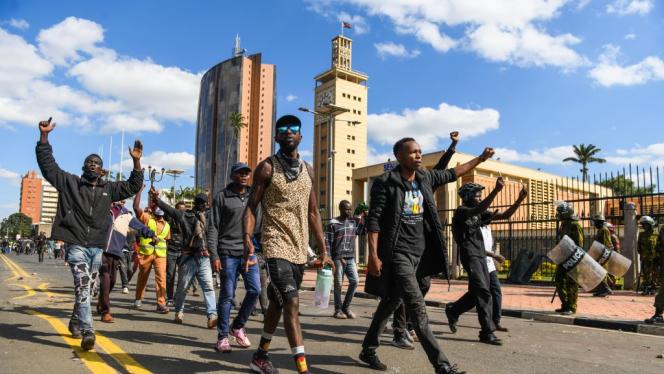Monday 16 September 2024
What can Somali youth learn from Kenya’s Gen Z uprising?

Kenyan youth unite beyond party and tribal ties to demand a voice in shaping their nation’s future. Can young Somalis learn from this and do the same?
In 2019, a picture of a young student and activist captured the headlines of leading newspapers, not just in Sudan but across continents. The picture featured a young woman standing on top of a white car, draped in a flowing traditional Sudanese white dress. Her right arm was outstretched, finger pointing skyward in a gesture of defiance. That young woman was Alaa Salah, a fearless young activist who became an icon of the Sudanese revolution and an icon of African youth and women's activism. She was standing up against Sudan’s then-autocratic ruler, Omar al-Bashir’s regime.
Exactly five years later, similar pictures of African youth, born and bred on this unfortunate continent, plagued by kakistocracy, which has become synonymous with struggle and adversity, are emerging from Kenya. Pictures are circulating on X, formerly Twitter, capturing young women and men rallying in masses, holding signs that read “Reject finance bill” in bold letters and using megaphones. Some of them stand in front of anti-riot police, their body language exuding fearless courage. On 25 June, police opened fire on protesters shooting dead at least five people, when some demonstrators attempted to storm the country’s parliament. Later that night Ruto would describe their actions as “treasonous”.
This protest was triggered by an unpopular bill, now passed, that seeks to increase taxes across several sectors, a move widely perceived as unfairly burdensome on the young. It still needs the president’s signature before it becomes law. Kenya is wracked with debt, the financing of which consumes a sizable share of the country’s revenue. Ruto has long wanted to reduce the country’s debt and believes increasing tax can help him achieve that goal despite warnings from industry specialists. Mohamed Wehliye, a senior adviser with Saudi Arabian monetary authority warned: “Agreeing to a revenue focused fiscal consolidation deal with [the] IMF was always going to cause a fight with the citizenry!” It did and Kenyans across the country, led by Generation Z, have taken to the streets to express their discontent, viewing the bill as punitive and detrimental to their livelihoods.
In response, the Kenyan government, led by President William Ruto, has decided to make concessions in an effort to calm the growing protests led by the youth. The government has specifically scrapped levies on cooking oil, mobile money services, and motor vehicles. Additionally, it has modified a proposed eco-tax on imported goods.
These protests, however, are just the tip of the spear for Kenyan youths, who are facing a storm of challenges. Unemployment rates are soaring, with many graduates struggling to find stable jobs. The Kenyan economy, once a promising emerging market in the region, has stalled, leaving young people feeling frustrated. Kenyan youth, like many across the continent, are left stranded, with their future’s uncertain and their hopes shrinking.
Despite having college degrees, the sight of young, unemployed graduates resorting to hanging rough-and-ready posters around their necks in hopes of securing employment is becoming all too common on the streets of Nairobi. Moreover, the scale of this protest reflects entrenched public frustration and anger over economic policies seen as disproportionately impacting young Kenyans. However, it also presents a unique set of opportunities that the country and the continent at large have never seen before.
Today, Kenyan Generation Z (Gen Z) has set a high standard. They have organised their protest peacefully, something that has been rare in Kenya and the continent. These protests are also leaderless and non-hierarchical and savvily utilise social media to to get organised, with pockets of resistance organically growing across the country. This has made them more resilient against attempts by politicians to subvert them, according to Kenyan political commentator Patrick Gathara. “We are all living in their world now,” he writes. These protests are also more civic in their ethos, transcending party and tribal loyalties. To grasp the magnitude of what the Kenyan youth have accomplished, a glance at history is necessary.
In 2007, Kenya experienced widespread protests and riots following the disputed presidential election on 27th December 2007. The election pitted incumbent President Mwai Kibaki, a member of the Kikuyu ethnic group, against opposition candidate Raila Odinga, a member of the Luo ethnic group. The election results were contested, with Odinga and his supporters claiming it was rigged, triggering massive riots. The ensuing violence resulted in over 1,000 deaths and tens of thousands displaced. Moreover, the riots exacerbated tribal animosities that continue to influence Kenyan politics today.
But this time, the new generation has opened new gates and new ways of protesting. They’ve been persistent and overwhelmingly peaceful. Unfortunately, as has often been the case, this new wave of youth with a different mindset has not been well-received by politicians. The political elites have never encountered such organisation, which makes them apprehensive. Rashid Abdi, a Kenyan political analyst, described these protests as a “tsunami,” adding, “where this tsunami leads is hard to know, but something profound is happening.”
Despite their peaceful demonstrations, which, as has often been the case in many parts of the African continent, have historically proven counterproductive, the police have forcefully attempted to crack down on the ongoing demonstrations. Activists, human rights groups and even former president Uhurru Kenyatta have criticised the police response, the excessive brutality and the use of lethal force. “If someone is fighting for their rights, why use bullets?” asked the grieving mother of one of the young victims who tragically lost his life in an interview with Al Jazeera. Live streamed videos across social media have also highlighted widespread violence resulting from police actions. Despite these challenges, the protests have continued to grow.
Central to the extraordinary organisation and peaceful mobilisation of these protests has been social media. Kenya’s young generation activists have utilised social media platforms to disseminate information, coordinate logistics, and rally mass support. Through social platforms, organisers and activists have shared updates and amplified their messages, often using hashtags such as #Rejectfinancebill and #Occupyparliment to reach a wider audience. For instance, the hashtag #Rejectfinancebill has garnered thousands of tweets on Twitter alone, with many users sharing and calling for broader protests. TikTok is also now replete with videos of your people sharing ideas, recording demonstrations and delivering powerful monologues on topical political issues. One TikToker, Peris Muthoni, asked the authorities directly: “What is in this bill that is worth taking lives for?”
Youth have historically been the driving force behind revolutions, shaping the course of history by bringing down powerful despotic rulers. From the student-led protests in Tiananmen Square in 1989, demanding democratic reforms in China, to the Arab Spring uprisings in 2011, toppling authoritarian regimes across the Middle East and North Africa, young people have demonstrated their power to inspire, lead change, and disrupt the system. The courage of young people to rise up and reject the status quo has proven to be the most powerful tool for confronting and disrupting oppressive systems.
In the United States, the Civil Rights Movement of the 1960s was led by young people who used nonviolent protests and civil disobedience to challenge racial segregation and discrimination. Similarly, the anti-apartheid movement in South Africa was fuelled by the activism of students, youth activists, and ordinary young people who risked their lives to oppose the cruel apartheid regime. Even in contemporary times, we continue to witness the power of youth-led protests. For instance, consider the recent protest by university students in the USA against Israel’s carpet-bombing campaign in Gaza. In Senegal too, it was months of protests by the supporters of Ousmane Sonko that played a crucial role in making Macky Sall accept his constitutional limit and step aside earlier this year. What all these revolutions have in common is the courage of young people to say no, their determination to unify their voices in pursuit of change.
At a time when neighbouring countries are experiencing revolutionary uprisings led by the youth, Somali youth, in contrast, appear to have accepted a bleak fate. Despite enduring 30 years of conflict, which has claimed countless young lives and left many in despair and uncertainty, the Somali people have largely remained silent. In return, they face a broken system—a fragmented nation burdened by terrorism, conflicts, and civil war. The country has gained the unfortunate distinction of being one of the most corrupt in modern history, enduring the longest civil war on the African continent. It has become a kakistocracy, a banana republic, unable to provide basic services to its citizens. Yet, despite these dire circumstances, significant change has yet to materialise. The small glimmer of hope lies in the fact that this hasn’t always been the case; Somalis have a history of youth-led protests that have reshaped the country’s history.
Somalia had one of the most impactful youth-led protests in the history of the continent, paving the way for the country’s independence and resisting one of the most brutal systems the world has ever seen—Italian colonial fascism. The legacy of this system and the seeds it planted continue to haunt Somalis across the region.
The Somali Youth League (SYL) was established by young Somalis who realised they could no longer endure the brutal violence, discrimination, and subjugation under colonial fascist and imperialist regimes. Prominent Somali intellectual Abdi Ismail Samatar vividly recounts the horrific treatment of Somalis by colonial fascists in his influential work, Africa's First Democrat. Among the numerous atrocities documented, Samatar highlights particularly heinous acts, such as Italian settlers “forcibly uniting men and women to increase the labour force” with the approval of colonial authorities. Samatar describes the daily humiliations imposed on Somalis, including rules that barred them from entering certain offices with their shoes on, and among the armed forces, a stark symbol of their subjugation and dehumanisation.
These examples of cruelty and repression were just a fraction of the countless brutalities endured by Somalis under fascist and imperial colonialism. However, this oppressive environment galvanised the creation of the Somali Youth League (SYL), a youth-led organisation that became a fundamental force in the fight for Somalia’s independence. In its early years, the SYL organised historic protests, including the Dhagahtuur uprising. “On that fateful day, January 11, SYL leaders assembled their supporters in the area of the city that came to be known as Dhagahtuur,” Samatar wrote. Through the relentless efforts of the SYL and their courageous struggle for liberty and freedom, the organisation emerged as the leading figure in securing Somalia's independence. Despite challenges today, Somalia remains a free nation, thanks to the courage of the Somali Youth League.
What is happening in Kenya—a youth-led and youth-organised protest—should serve as a lesson to Somali youth for several reasons. Firstly, the issues Kenyan youth are protesting against mirror the challenges faced by Somali youth: a dysfunctional and broken system, soaring unemployment, indifferent oligarchs, and a crisis in the cost of living. However, what sets Kenyan youth apart from their Somali counterparts is their decision to set aside differences, reject the false promises of political oligarchs, and unite for the greater good of their generation and future generations. This is where Somali youth could learn from their counterparts. By putting aside clan allegiances and tribalism, the country’s young people represent its only hope. This was what made the Somali Youth League (SYL) successful in their campaign for liberty and freedom. Failing to embrace the ideals of SYL or ignoring the developments in the region would be akin to consigning the country to perpetual ruin. Kenyan youth have shown the continent the way; it is now up to African youth, including Somali youth, to rise and demand change.










